|
|
|
Sort Order |
|
|
|
Items / Page
|
|
|
|
|
|
|
| Srl | Item |
| 1 |
ID:
137182
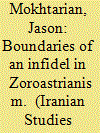

|
|
|
|
|
| Summary/Abstract |
This paper explores the Middle Persian term agdēn, which is often problematically translated as “infidel.” By tracing this term of otherness through Middle Persian texts such as legal cases in The Book of a Thousand Judgments and polemics in the Dēnkard Book III, this article argues that the concept of the infidel frequently appears in discussions about slavery, intermarriage, and conversion to and from Zoroastrianism. Middle Persian legal and theological texts regarding infidels deal with cases in which Zoroastrian interactions with non-Zoroastrians impinge upon Zoroastrian boundaries of identity. Moreover, the term agdēn often refers to Jews, Christians, and Muslims, thereby offering insight into the ties between Zoroastrian self-identity and other groups which the Persian priests encountered. In the end, this paper demonstrates the need for further intensive studies into Middle Persian technical terms of otherness as they lie at the heart of questions of Zoroastrian self-definition and attitudes towards others.
|
|
|
|
|
|
|
|
|
|
|
|
|
|
|
|
| 2 |
ID:
129007
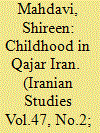

|
|
|
|
|
| Publication |
2014.
|
| Summary/Abstract |
The history of children in general and that of Persian children in particular is that of the inarticulate. The social history of Iran is a neglected field although in recent decades a preponderance of material has appeared on the history of women. Aside from this no work has been undertaken on the private life of the period including childhood and family life. This article examines various aspects of the position and upbringing of children in Qajar Iran ranging from the rearing of children to their status in the family, discipline, amusements and education. This investigation attempts to cover the childhood of different sexes and social classes both in rural and urban areas. The discussion is limited to Shi'i children, the majority population of Iran.
|
|
|
|
|
|
|
|
|
|
|
|
|
|
|
|
| 3 |
ID:
129010
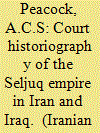

|
|
|
|
|
| Publication |
2014.
|
| Summary/Abstract |
This paper reexamines the Arabic and Persian historical literature of the Seljuq period (1040-1194), concentrating on works produced in circles connected with the sultanic court. It considers the relationship between the Arabic and Persian works, the authors' motives for composition, and the reasons for choice of language. It also compares these works with their predecessors, especially the historiography of the Ghaznavid court, with a view to assessing the particular characteristics of Seljuq historical writing, which is often considered rather slight and unimpressive. One reason that is often adduced for this is the absence of dynastic history writing under the Seljuqs, and the alleged lack of interest of the Seljuq court in patronizing historiography, themes which we also investigate here.
|
|
|
|
|
|
|
|
|
|
|
|
|
|
|
|
| 4 |
ID:
129004
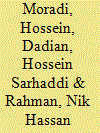

|
|
|
|
|
| Publication |
2014.
|
| Summary/Abstract |
This paper consists of some of the findings of the authors during their research at prehistoric sites of Bampur and its surrounding areas in August 2011. These areas, which have been introduced as Bampur-related sites, comprise an area about of 5-10 kilometers and belong to the Bronze Age. The paper introduces, categorizes and analyzes the archaeological findings in relation to the Bampur collection. The archaeological findings show that: (1) unlike the previous belief, there existed a peak settlement dated back to the Chah Husseini period which was prior to Bampur I; (2) in fact, Bampur II-IV had larger populations due to growth of trade and commerce and their relations with Yahya and Mesopotamia; (3) the later periods of the Bampur collection show a decreasing number of sites at Bampur VI.
|
|
|
|
|
|
|
|
|
|
|
|
|
|
|
|
| 5 |
ID:
129015
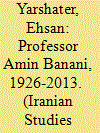

|
|
|
|
|
| Publication |
2014.
|
| Summary/Abstract |
Professor Amin Banani was one of the pillars of Iranian Studies in the United States and his passing leaves a conspicuous and regrettable gap in providing instruction and guidance with respect to Iranian history and Persian literature. He could speak with authority about the entire field of Iranian Studies, even though his expertise did not extend to pre-Islamic Iranian languages and religions.
|
|
|
|
|
|
|
|
|
|
|
|
|
|
|
|
| 6 |
ID:
129003
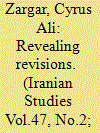

|
|
|
|
|
| Publication |
2014.
|
| Summary/Abstract |
This article examines four mystical treatises by the Safavid scholar Fayd al-K?sh?n? (d. 1090/1679). Of the four, al-Kalim?t al-Makn?na ("the Hidden Words") serves as the basis for the three other versions, al-La'?li', Qurrat al-'Uy?n, and al-Kalim?t al-Makhz?na, composed at different times for different audiences. Comparison of their structure and content reveals changes that occurred in K?sh?n?'s presentation of the thought of Ibn 'Arab? and Mull? Sadr?. K?sh?n?'s later emphasis on Shi'i hadith sources says much about the context in which he wrote and perhaps more about his later assessment of the place of sufi cosmology, Islamic philosophy, and scripture in scholarly and popular circles.
|
|
|
|
|
|
|
|
|
|
|
|
|
|
|
|
| 7 |
ID:
129006
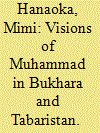

|
|
|
|
|
| Publication |
2014.
|
| Summary/Abstract |
Persian authors couched claims to the religio-political authority and legitimacy of their cities through dream narratives in local histories written between the tenth and thirteenth centuries. Persians did not always fit neatly into genealogical claims to legitimacy like the Arab descendants of Mu?ammad and his clan, and dreams form alternate avenues that sanctify and legitimate specific Persian cities and individuals. Dream narratives embedded in T?r?kh-i Bukh?r? and T?r?kh-i ?abarist?n are literary devices that bring the prestige of religious authority to their city and province and to specific persons. These dream narratives are not only windows into understanding the broader social, political, and religious contexts of local histories but also the particular anxieties and priorities of the authors.
|
|
|
|
|
|
|
|
|
|
|
|
|
|
|
|
|
|
|
|
|